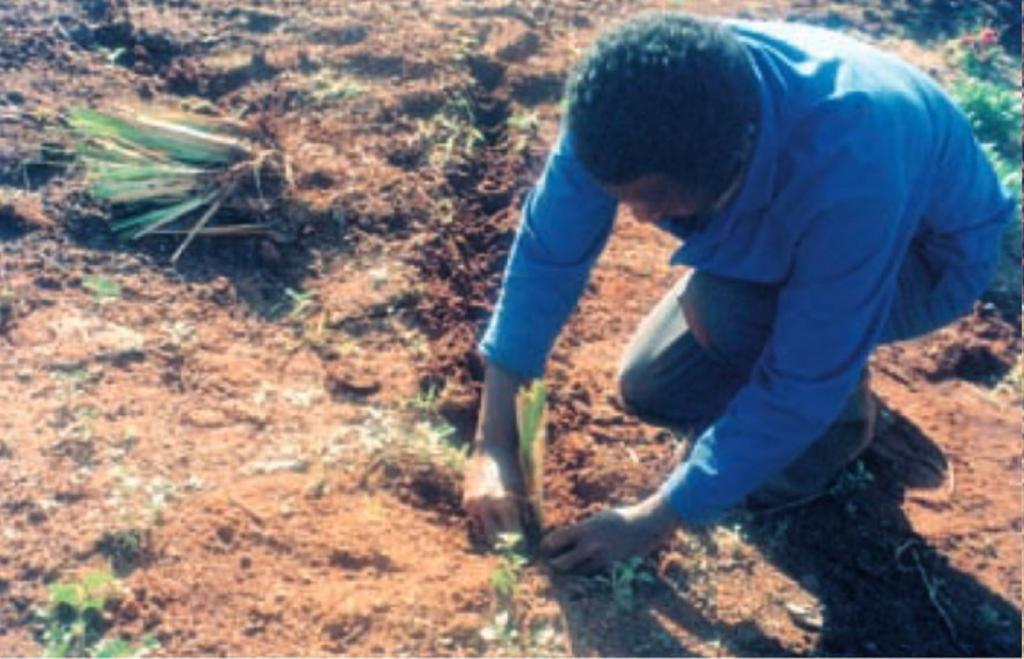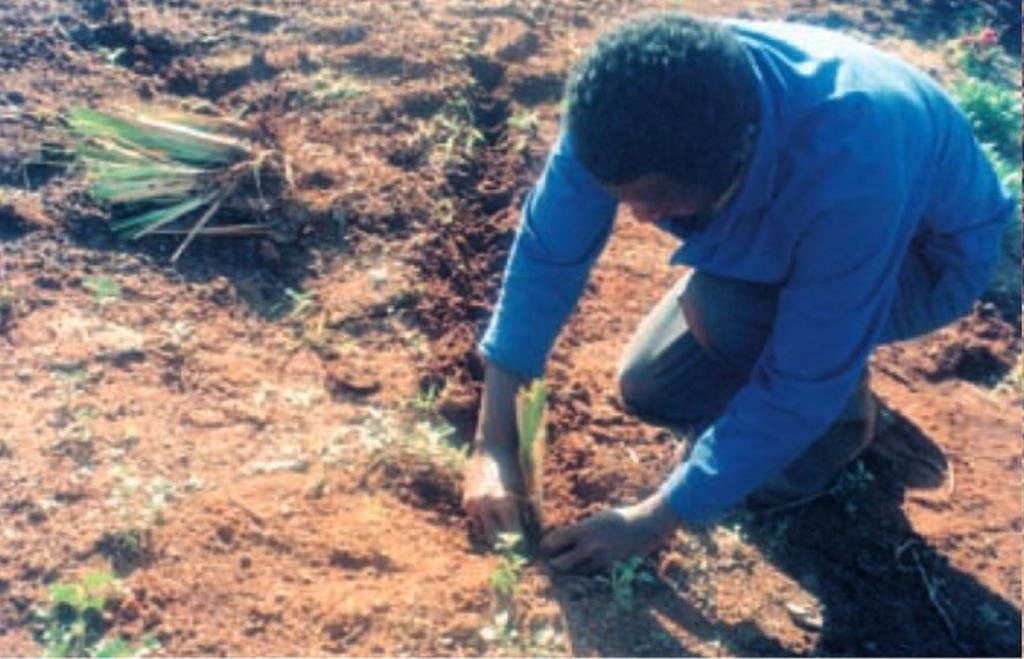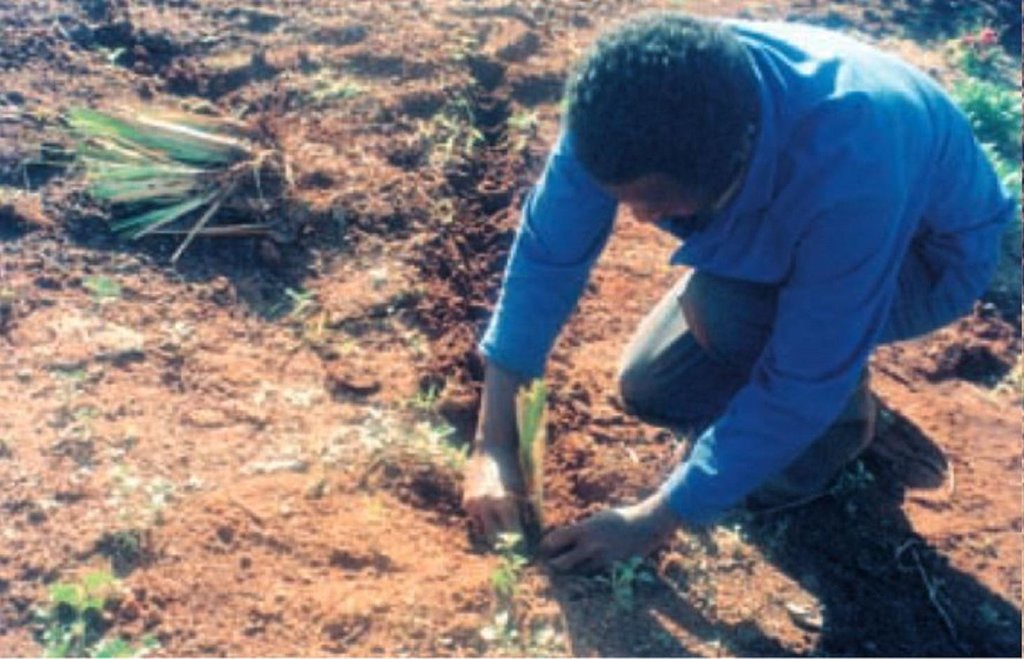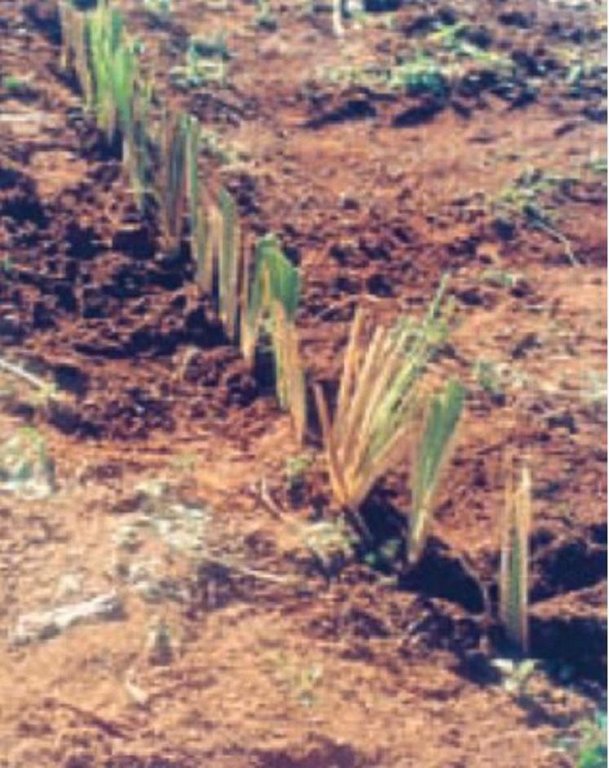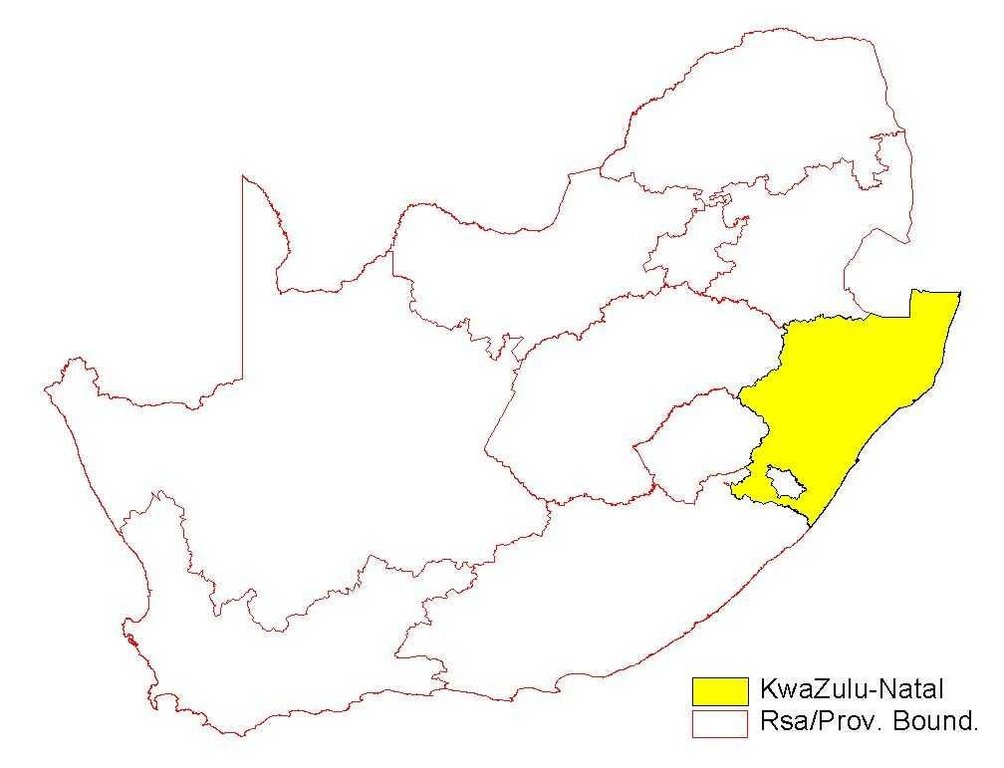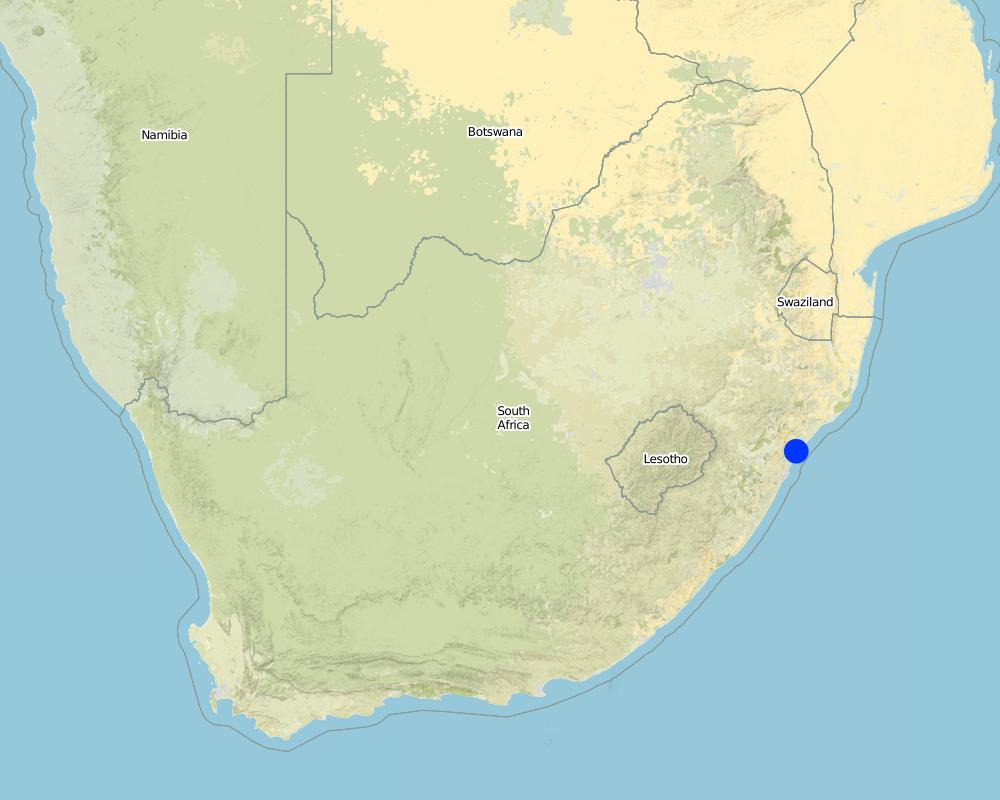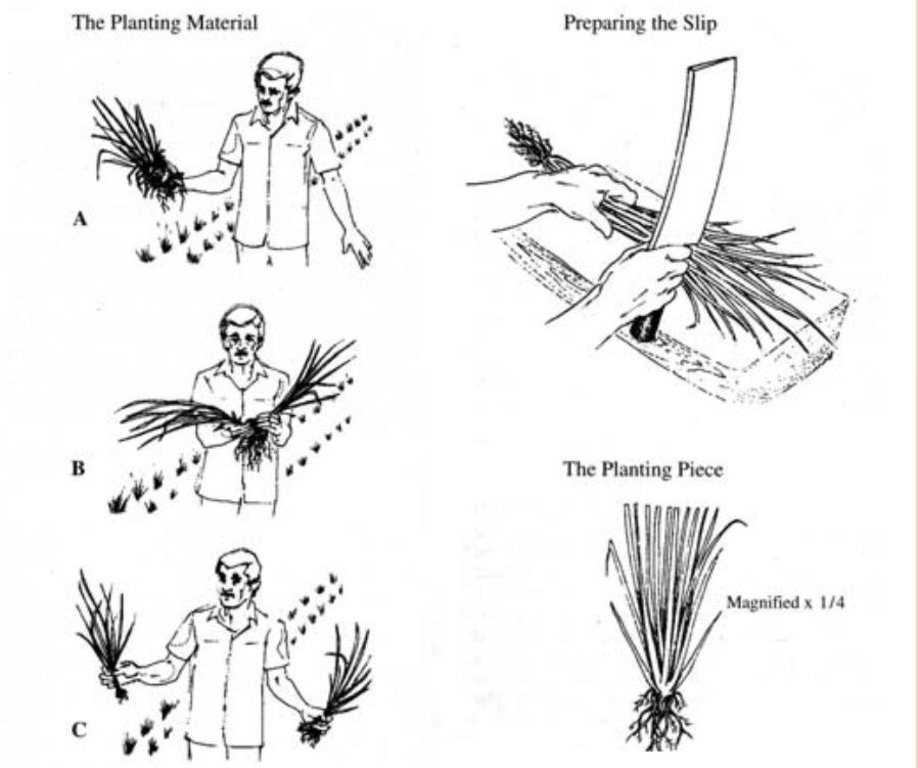Self teaching [南非]
- 创建:
- 更新:
- 编制者: Philippe Zahner
- 编辑者: –
- 审查者: Fabian Ottiger, Deborah Niggli
approaches_2611 - 南非
查看章节
全部展开 全部收起1. 一般信息
1.2 参与方法评估和文件编制的资源人员和机构的联系方式
SLM专业人员:
van der Merwe Rinda
rinda@arc.agric.za
Institute for Soil, Climate and Water
P/Bag x79, 0001 Pretoria
南非
有助于对方法进行记录/评估的项目名称(如相关)
Book project: where the land is greener - Case Studies and Analysis of Soil and Water Conservation Initiatives Worldwide (where the land is greener)有助于对方法进行记录/评估的机构名称(如相关)
Swiss Agency for Development and Cooperation (DEZA / COSUDE / DDC / SDC) - 瑞士有助于对方法进行记录/评估的机构名称(如相关)
Institute for Soil, Climate & Water - 南非1.3 关于使用通过WOCAT记录的数据的条件
编制者和关键资源人员接受有关使用通过WOCAT记录数据的条件。:
是
1.4 SLM技术问卷的参考
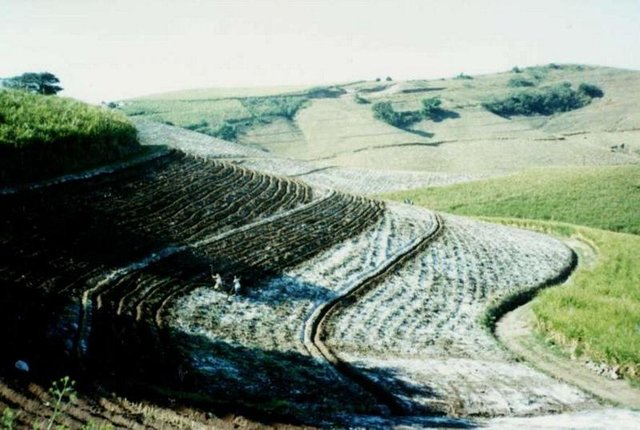
Vetiver grass soil conservation system [南非]
Contour lines of vetiver grass planted within fields of sugar cane, on stream banks and roadsides, to act as ‘hedges against erosion’.
- 编制者: Unknown User
2. SLM方法的描述
2.1 该方法的简要说明
Learning how to use vetiver grass as a vegetative conservation barrier through instructions from a booklet and hands-on practical experience.
2.2 该方法的详细说明
该方法的详细说明:
Aims / objectives: The manager of the farm was given a book and video on vetiver grass by the Mazda group from UK. His objective was to teach himself to improve his conservation system. Already he had a number of consercation strategies, including terracing, minimum tillage, mulching and strip-cropping, but he felt there was a need to better his syste,. Through self-teaching he gave himself an oppurtunity to do so.
There had been some vetiver plants on the farm for 40 years, and it held the soil in place where it grew. This vetiver grew into huge clumps comprising many splits (tillers). The book demonstrated how vetiver could be dug up, split and planted in a continuous barrier hedge for soil and water conservation. In other words, the book offered the possibility of improving on what was already there.
The approach therefore was to take ideas from a book, testing those ideas and see how they worked in practice. The approach has developed further by the farmer spreading his message to neighbours, some of whom have copied the system after visiting his farm and seeing the results for themselves. While the original handbook had been aimed especially at Indian farmers, subsequent to the successful experience of this particular farmer, a locally focussed handbook has been recently prepared in English and Zulu by the South African Vetiver Network.
2.3 该方法的照片
2.5 采用该方法的国家/地区/地点
国家:
南非
区域/州/省:
Kwa-Zulu Natal
有关地点的进一步说明:
Lower Tugela District, South Africa
Map
×2.6 该方法的开始和终止日期
注明开始年份:
1989
2.8 该方法的主要目的/目标
The Approach focused on SLM only
test and try a new method by self-teaching and gaining hands-on experience
The SLM Approach addressed the following problems: lack of knowledge about alternative conservation technologies, need for a new and cheap supplement to existing forms of soil and water conservation within sugar cane, that could be tested and tried by the farmer himself without need for outside advice.
2.9 推动或妨碍实施本办法所适用的技术的条件
财务资源和服务的可用性/可得性
- 阻碍
Need to find a cheap supplement to existing SWC in sugar cane
Treatment through the SLM Approach: Discovery of vetiver grass barrier hedge technology described in a booklet
法律框架(土地使用权、土地和水使用权)
- 启动
The existing land ownership, land use rights / water rights greatly helped the approach implementation: Made own decision and started to implement immediately
3. 相关利益相关者的参与和角色
3.1 该方法涉及的利益相关者及其职责
- 当地土地使用者/当地社区
Working land users were mainly men (Also women, the men are used for more physical work (harder))
3.2 当地土地使用者/当地社区参与该方法的不同阶段
| 当地土地使用者/当地社区的参与 | 指定参与人员并描述活动 | |
|---|---|---|
| 启动/动机 | 自我动员 | looking for ideas |
| 计划 | 自我动员 | reading and thinking through the possibilities |
| 实施 | 自我动员 | paying farm labourers to plant the grass |
| 监测/评估 | 自我动员 | observation |
| Research | 无 | not applicable |
3.3 流程图(如可用)
具体说明:
Establishing vetiver hedges: instructions on preparation for planting in the vetiver handbook.
作者:
World Bank, 1990
3.4 有关SLM技术选择的决策
具体说明谁有权决定选择要实施的技术:
- 仅限土地使用者(自主)
解释:
land user driven (bottom-up). Literature
Decisions on the method of implementing the SLM Technology were made by by land users* alone (self-initiative / bottom-up). land user driven (bottom-up).
4. 技术支持、能力建设和知识管理
4.1 能力建设/培训
是否为土地使用者/其他利益相关者提供培训?:
是
明确受训人员:
- 土地使用者
如果相关,请说明性别、年龄、地位、种族等。:
self-taught through use of World Bank's vetiver handbook
培训形式:
- self-taught, hands-on experience
4.4 监测和评估
监测和评估是该方法的一部分吗?:
是
注释:
bio-physical aspects were regular monitored by land users through observations; indicators: vetiver performance
technical aspects were ad hoc monitored by land users through observations
economic / production aspects were ad hoc monitored by land users through observations
area treated aspects were regular monitored by land users through measurements
no. of land users involved aspects were ad hoc monitored by land users through observations
There were no changes in the Approach as a result of monitoring and evaluation
There were no changes in the Technology as a result of monitoring and evaluation
5. 融资和外部物质支持
5.1 该方法中SLM组成部分的年度预算
注释(例如主要的资助来源/主要捐助者):
Approach costs were met by the following donors: other (farmer itself): 100.0%
5.2 为土地使用者提供财政/物质支援
土地使用者是否获得实施该技术的财政/物质支持?:
否
5.3 对特定投入的补贴(包括劳动力)
如果土地使用者的劳动力是一项重要的投入,那么是不是:
- 自愿
5.4 信用
是否根据SLM活动的方法给予信用值?:
否
6. 影响分析和结论性陈述
6.1 方法的影响
该方法是否帮助土地使用者实施和维护SLM技术?:
- 否
- 是,很少
- 是,中等
- 是,支持力度很大
Land users can continue without support and at least a modest spontaneous expansion of adoption is expected.
Did other land users / projects adopt the Approach?
- 否
- 是,很少
- 是,中等
- 是,支持力度很大
Three neighbouring farmers have adopted the technology throught their observations
6.3 方法活动的可持续性
土地使用者能否维持通过该方法实施的措施(无外部支持的情况下)?:
- 是
若是,请说明如何维持:
Land users can continue without support and at least a modest spontaneous expansion of adoption is expected.
6.4 该方法的长处/优点
| 土地使用者眼中的长处/优势/机会 |
|---|
| Neighbours can easily see and copy (How to sustain/ enhance this strength: Farmer-to-farmer visits could be promoted through self-help groups and associations.) |
| A very cheap method of extension/knowledge transfer (How to sustain/ enhance this strength: Produce and disseminate booklets and information on the internet more widely.) |
| 编制者或其他关键资源人员认为的长处/优势/机会 |
|---|
| A technical system devised from a handbook and experience rather than needing a project or intensive visits from extension agents (How to sustain/ enhance this strength: Make sure such handbooks are spread and available in local languages.) |
6.5 该方法的弱点/缺点以及克服它们的方法
| 编制者或其他关键资源人员认为的弱点/缺点/风险 | 如何克服它们? |
|---|---|
| Not everyone has access to such teaching material or is literate | Spread literature and information more widley and in local languages both in written form and on the radio. |
7. 参考和链接
7.1 方法/信息来源
- 实地考察、实地调查
- 与土地使用者的访谈
7.2 参考可用出版物
标题、作者、年份、ISBN:
World Bank (1990): Vetiver Grass: The Hedge against Erosion
可以从哪里获得?成本如何?
World Bank, Washington D.C.
链接和模块
全部展开 全部收起链接

Vetiver grass soil conservation system [南非]
Contour lines of vetiver grass planted within fields of sugar cane, on stream banks and roadsides, to act as ‘hedges against erosion’.
- 编制者: Unknown User
模块
无模块


